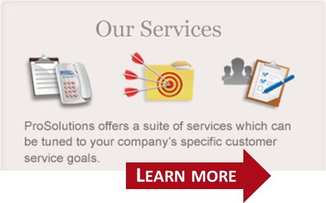 I personally don't think that the Customer Experience can be explored enough. One of the main reasons that ProSolutions re-branded in 2001 was because I could see that we were leaving important needs on the table. Companies saw us as one dimensional. In order for us to re-communicate our message of what we could do for our customers, we built new operational models that showed how we could influence all aspects of the Total Customer Experience. So often we would hear from our customers that they need us to "fix" their broken service and delivery. Ten out of ten times, based on our analysis, we would quickly determine that the broken service and delivery (customer experience) was a byproduct of the whole organization being fragmented. Meaning, in many organizations, the "whole" runs as individual department silos.
I personally don't think that the Customer Experience can be explored enough. One of the main reasons that ProSolutions re-branded in 2001 was because I could see that we were leaving important needs on the table. Companies saw us as one dimensional. In order for us to re-communicate our message of what we could do for our customers, we built new operational models that showed how we could influence all aspects of the Total Customer Experience. So often we would hear from our customers that they need us to "fix" their broken service and delivery. Ten out of ten times, based on our analysis, we would quickly determine that the broken service and delivery (customer experience) was a byproduct of the whole organization being fragmented. Meaning, in many organizations, the "whole" runs as individual department silos.
To create great customer experiences, every customer touchpoint within an organization must be exceptional. In order for that to happen, a customer experience program or initiative must be in place, understood, and excepted by all. To help me explain this further, a friend of mine, Roy Barnes, wrote a great book with Bob Kelleher, called, Customer Experience for Dummies. In this book he has outlined 8 steps to creating a great customer service program, which I think are spot on. Let's review Barnes and Kelleher's 8 Steps:
- Developing and deploying your customer experience intent statement: Barnes describes this as not a marketing slogan, but more of a set of engineering schematics. He says, "It's a formal, defined set of criteria against which the organization can manage and monitor the delivery of customer experience."
- Building touchpoint maps: To provide the best customer experience, you need to know how your customer uses your business. All that impacts your customer's experience across the entire organization needs to be identified and analyzed.
- Redesigning touchpoints: After identifying and analyzing all touchpoints, very often you will determine that many will need to be redesigned to improve the experience.
- Creating a dialogue with your customers: When it comes to getting feedback from your customers Barnes says, "annual surveys are out, and constant listening and providing real-time dialogue is in."
- Building customer experience knowledge in the workplace: This one I feel is one of the biggest misses in businesses today. Employees that have regular contact with the customer need to be trained not only on how to execute the functions of their job, but most importantly, what it looks like delivering great customer service. No guessing.
- Recognizing and rewarding a job well done: Rewards and compensations can't be just tied to numbers, they must also focus on the delivery of customer experiences.
- Executing an integrated internal communication plan: Barnes says, "The fact is, making your organization customer-centric is an uphill battle. It is winnable, but significant resources, both financial and philosophical, need to be brought to bear, including a robust internal communications effort."
- Building a customer experience dashboard: Feel-good customer initiatives are a no-go, says Barnes. "These must be replaced with laser-guided projects supported by clear and formal performance metrics with assigned and owned commitments."
Great customer experiences don't just happen by chance, they are made to happen from detailed efforts of planning, understanding. and communicating. It has to be a unified company effort in order to be successful. Need help?



